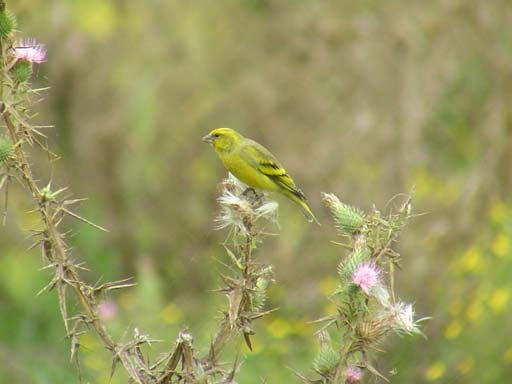m |
(Some extra info. References updated.) |
||
| Line 1: | Line 1: | ||
| − | [[Image:28523Yellow-crowned_Canary.jpg|thumb| | + | [[Image:28523Yellow-crowned_Canary.jpg|thumb|550px|right|Photo by {{user|Shailesh+Patel|Shailesh Patel}} <br />Lake Naivasha, [[Kenya]], November 2006]] |
;[[:Category:Serinus|Serinus]] flavivertex | ;[[:Category:Serinus|Serinus]] flavivertex | ||
==Identification== | ==Identification== | ||
| − | 11-13 cm<br /> | + | 11-13 cm (4-5 in)<br /> |
'''Adult male''' | '''Adult male''' | ||
| + | *Golden-yellow forehead and crown | ||
*Black and yellow back with black edged wing feathers wings and tail | *Black and yellow back with black edged wing feathers wings and tail | ||
*Bright yellow underparts, rump and tail sides | *Bright yellow underparts, rump and tail sides | ||
| Line 11: | Line 12: | ||
Highlands from [[Eritrea]] to [[Malawi]], and highlands of western [[Angola]]. | Highlands from [[Eritrea]] to [[Malawi]], and highlands of western [[Angola]]. | ||
==Taxonomy== | ==Taxonomy== | ||
| − | Three subspecies are recognised: | + | Formerly considered conspecific with [[Cape Canary]]. |
| + | ====Subspecies==== | ||
| + | Three subspecies are recognised<sup>[[#References|[1]]]</sup>: | ||
*''S. f. flavivertex''; [[Eritrea]] to northern [[Tanzania]]. | *''S. f. flavivertex''; [[Eritrea]] to northern [[Tanzania]]. | ||
*''S. f. sassi''; south-western [[Uganda]], eastern [[Zaire]], southern [[Tanzania]], northern Malawi and north-eastern [[Zambia]]. | *''S. f. sassi''; south-western [[Uganda]], eastern [[Zaire]], southern [[Tanzania]], northern Malawi and north-eastern [[Zambia]]. | ||
*''S. f. huillensis''; highlands of western [[Angola]]. | *''S. f. huillensis''; highlands of western [[Angola]]. | ||
| − | |||
==Habitat== | ==Habitat== | ||
Scrub and grasslands with trees, copses, plantations, gardens, parks, road verges, croplands, orchards, fybos, montane grasslands. Most common in highland areas. | Scrub and grasslands with trees, copses, plantations, gardens, parks, road verges, croplands, orchards, fybos, montane grasslands. Most common in highland areas. | ||
| Line 26: | Line 28: | ||
It builds a compact cup nest, commonly in a shrub. | It builds a compact cup nest, commonly in a shrub. | ||
==References== | ==References== | ||
| − | # Fry H, Keith S,Woodcook M & Willis I. 2004. ''Birds of Africa Vol VII: Sparrows to Buntings''. Princeton University Press. ISBN 0713665319 | + | #{{Ref-Clements6thAug14}}#Fry H, Keith S,Woodcook M & Willis I. 2004. ''Birds of Africa Vol VII: Sparrows to Buntings''. Princeton University Press. ISBN 0713665319 |
| − | # | + | #{{Ref-Hockeyetal05}}#{{Ref-SinclairRyan03}} |
| − | # | ||
#AvianWeb | #AvianWeb | ||
| + | #Handbook of the Birds of the World Alive (retrieved July 2015) | ||
{{ref}} | {{ref}} | ||
==External Links== | ==External Links== | ||
{{GSearch|Serinus+flavivertex}} | {{GSearch|Serinus+flavivertex}} | ||
[[Category:Birds]] [[Category:Serinus]] | [[Category:Birds]] [[Category:Serinus]] | ||
Revision as of 22:33, 2 July 2015
- Serinus flavivertex
Identification
11-13 cm (4-5 in)
Adult male
- Golden-yellow forehead and crown
- Black and yellow back with black edged wing feathers wings and tail
- Bright yellow underparts, rump and tail sides
- White lower belly
- Cinnamon face
Distribution
Highlands from Eritrea to Malawi, and highlands of western Angola.
Taxonomy
Formerly considered conspecific with Cape Canary.
Subspecies
Three subspecies are recognised[1]:
- S. f. flavivertex; Eritrea to northern Tanzania.
- S. f. sassi; south-western Uganda, eastern Zaire, southern Tanzania, northern Malawi and north-eastern Zambia.
- S. f. huillensis; highlands of western Angola.
Habitat
Scrub and grasslands with trees, copses, plantations, gardens, parks, road verges, croplands, orchards, fybos, montane grasslands. Most common in highland areas.
Behaviour
Occurs singly, in pairs, or in flocks of up to 500.
Diet
Forages for seeds on ground, and in scrub, weeds, and trees.
Breeding
It builds a compact cup nest, commonly in a shrub.
References
- Clements, J. F., T. S. Schulenberg, M. J. Iliff, D. Roberson, T. A. Fredericks, B. L. Sullivan, and C. L. Wood. 2014. The eBird/Clements checklist of birds of the world: Version 6.9., with updates to August 2014. Downloaded from http://www.birds.cornell.edu/clementschecklist/download/
- Fry H, Keith S,Woodcook M & Willis I. 2004. Birds of Africa Vol VII: Sparrows to Buntings. Princeton University Press. ISBN 0713665319
- Hockey, PAR, WRJ Dean, and PG Ryan, eds. 2005. Roberts' Birds of Southern Africa. 7th ed. Cape Town: John Voelcker Bird Book Fund. ISBN 978-0620340533
- Sinclair, I and P Ryan. 2003. Birds of Africa South of the Sahara. Princeton: Princeton Univ. Press. ISBN 978-0691118154
- AvianWeb
- Handbook of the Birds of the World Alive (retrieved July 2015)
Recommended Citation
- BirdForum Opus contributors. (2024) Yellow-crowned Canary. In: BirdForum, the forum for wild birds and birding. Retrieved 18 April 2024 from https://www.birdforum.net/opus/Yellow-crowned_Canary




